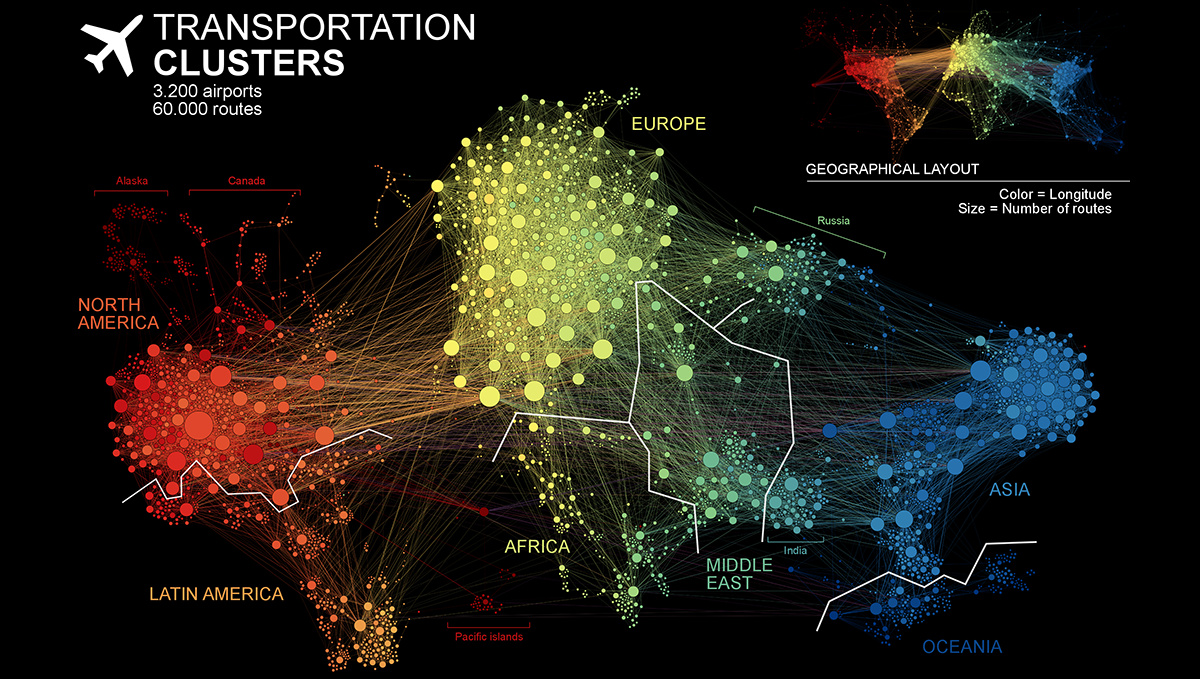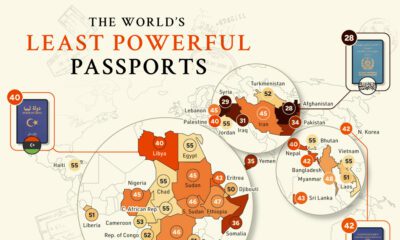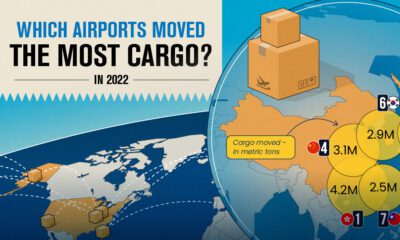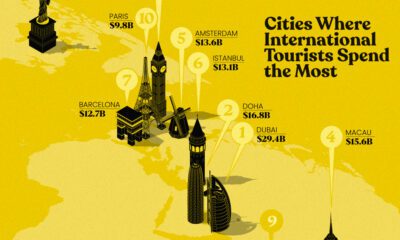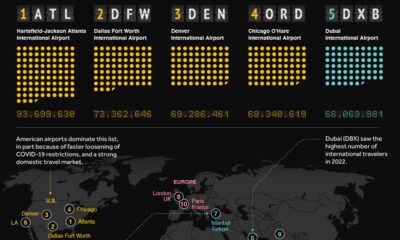Misc
A Network Map of the World’s Air Traffic Connections
View a high resolution version of this graphic
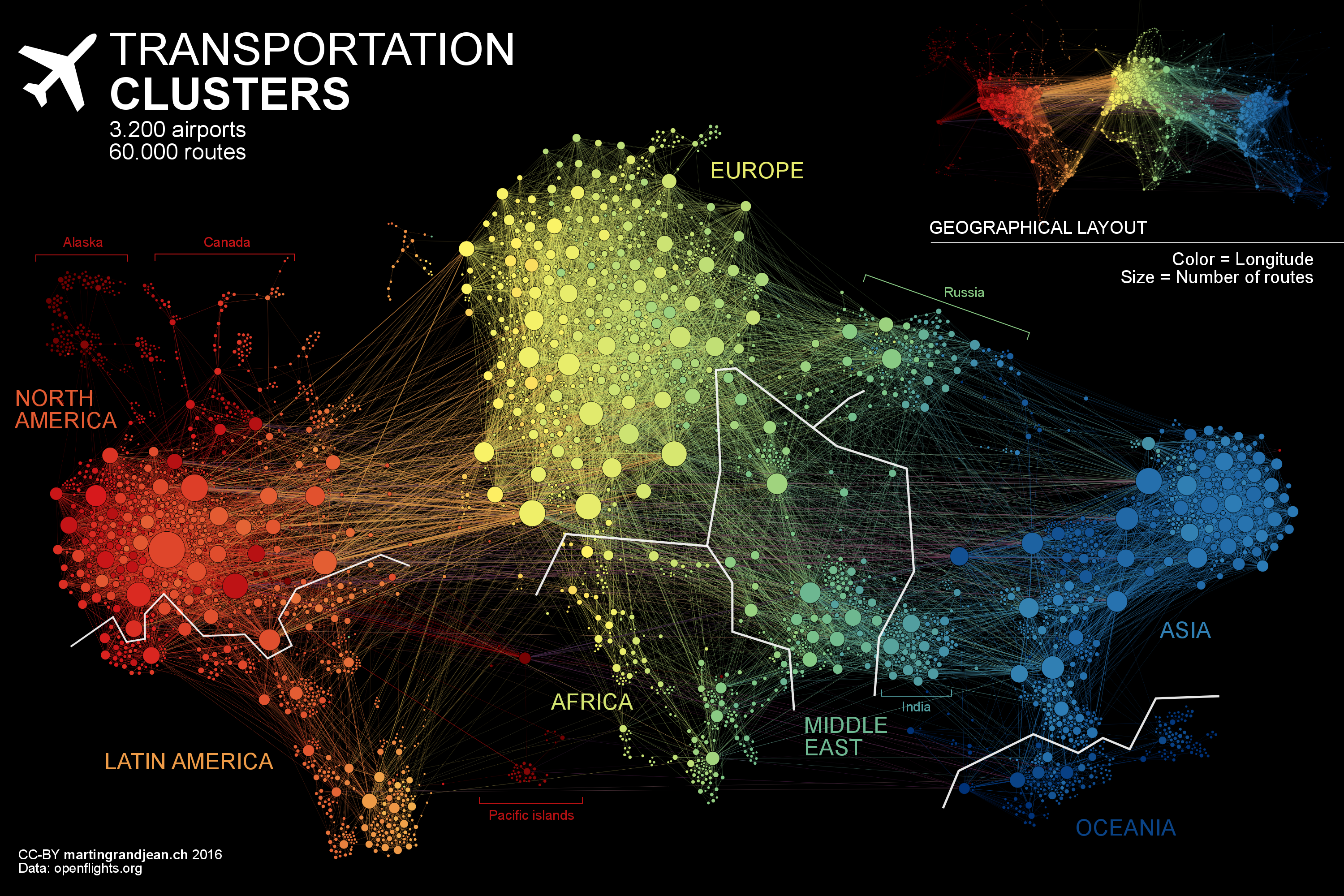
A Network Map of the World’s Air Traffic Connections
View the high resolution version of today’s graphic by clicking here.
In 2017, airlines moved over four billion passengers, a number that continues to grow each year.
As more and more people around the world can afford to scratch their travel itch, new connections and airports will be created to meet that demand. Remarkably, the world’s air transport network doubles in size every 15 years, and the International Civil Aviation Organisation (ICAO) estimates that it will do so again by the year 2030.
Today’s data visualization – created by researcher, Martin Grandjean – is a dramatic look at over 3,200 air traffic hubs that connect our world’s population centers. The unique, force-directed layout allows us to see relationships beyond geographical location.
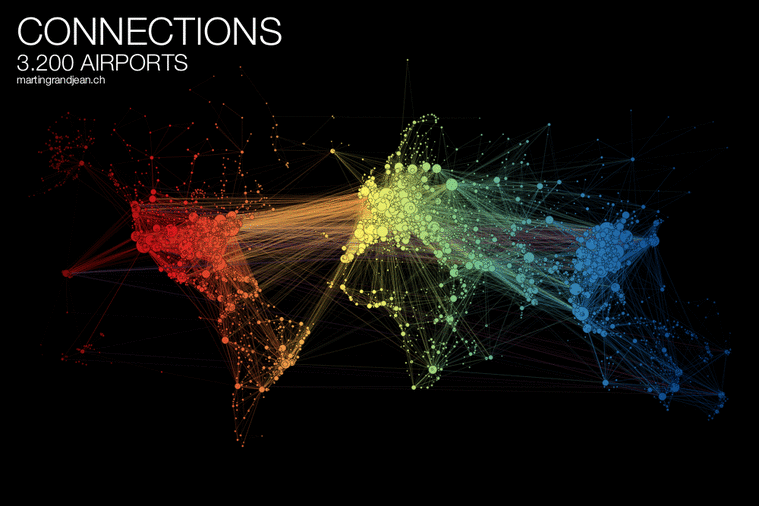
As the GIF above reveals, Europe remains an important linchpin in international travel, and cities on North America’s West Coast – such as Vancouver and San Francisco – swing in response to Asia’s gravitational pull.
The World’s Most Connected Airports
While all airports are effective at moving passengers from point A to B, particular locations play a crucial role in the global network. To help put this connectivity between airports into perspective, OAG created the Megahubs International Index.
Below are the top 50 internationally connected airports:
| Rank | Airport | Airport Name | Country | Connectivity Index |
|---|---|---|---|---|
| 1 | LHR | Heathrow | United Kingdom | 379 |
| 2 | FRA | Frankfurt | Germany | 307 |
| 3 | AMS | Amsterdam Schiphol | Netherlands | 299 |
| 4 | ORD | O'Hare | United States | 295 |
| 5 | YYZ | Toronto Pearson | Canada | 271 |
| 6 | SIN | Singapore Changi | Singapore | 257 |
| 7 | CGK | Soekarno–Hatta | Indonesia | 256 |
| 8 | ATL | Hartsfield–Jackson | United States | 256 |
| 9 | KUL | Kuala Lumpur | Malaysia | 242 |
| 10 | CDG | Charles de Gaulle | France | 242 |
| 11 | LAX | Los Angeles | United States | 235 |
| 12 | HKG | Hong Kong | Hong Kong | 233 |
| 13 | BKK | Suvarnabhumi | Thailand | 226 |
| 14 | MUC | Munich | Germany | 221 |
| 15 | IST | Istanbul Atatürk | Turkey | 219 |
| 16 | MIA | Miami | United States | 204 |
| 17 | ICN | Incheon | South Korea | 196 |
| 18 | JFK | John F. Kennedy | United States | 195 |
| 19 | IAH | George Bush | United States | 184 |
| 20 | DXB | Dubai | United Arab Emirates | 183 |
| 21 | MEX | Mexico City | Mexico | 176 |
| 22 | EWR | Newark Liberty | United States | 170 |
| 23 | PVG | Shanghai Pudong | China | 167 |
| 24 | SYD | Sydney | Australia | 167 |
| 25 | DEL | Indira Gandhi | India | 166 |
| 26 | YVR | Vancouver | Canada | 165 |
| 27 | DFW | Dallas/Fort Worth | United States | 164 |
| 28 | HND | Haneda | Japan | 163 |
| 29 | SFO | San Francisco | United States | 153 |
| 30 | FCO | Rome Fiumicino | Italy | 145 |
| 31 | PEK | Beijing Capital | China | 142 |
| 32 | CAN | Guangzhou Baiyun | China | 141 |
| 33 | BOM | Chhatrapati Shivaji | India | 140 |
| 34 | MAD | Madrid–Barajas | Spain | 138 |
| 35 | NCE | Nice Côte d'Azur | France | 133 |
| 36 | JNB | O. R. Tambo | South Africa | 133 |
| 37 | NRT | Narita | Japan | 132 |
| 38 | MNL | Ninoy Aquino | Philippines | 131 |
| 39 | SEA | Seattle–Tacoma | United States | 130 |
| 40 | BOS | Logan | United States | 128 |
| 41 | BOG | El Dorado | Colombia | 127 |
| 42 | GRU | São Paulo–Guarulhos | Brazil | 120 |
| 43 | YUL | Montréal–Trudeau | Canada | 118 |
| 44 | ZRH | Zurich | Switzerland | 115 |
| 45 | SVO | Sheremetyevo | Russian Fed. | 114 |
| 46 | SJU | Luis Muñoz Marín | Puerto Rico | 114 |
| 47 | PTY | Tocumen | Panama | 108 |
| 48 | VIE | Vienna | Austria | 107 |
| 49 | MCO | Orlando | United States | 107 |
| 50 | AKL | Auckland | New Zealand | 106 |
The heavyweight airport leading the world in international connectivity is London Heathrow. This busy air traffic hub recently had a mind-blowing 72,000 possible international connections within a 6-hour window of arriving and departing flights. Heathrow moved over 78 million passengers and 1.70 million metric tonnes of cargo in 2017.
According to OAG, Singapore Changi and El Dorado International Airport in Colombia were the most connected airports in Asia–Pacific and South America, respectively. O. R. Tambo International Airport near Johannesburg was the sole African airport to crack the top 50.
America’s Most Connected Airports
Below are the top 25 most connected airports in the United States:
| Rank | Airport | Airport Name | City | Connectivity Index |
|---|---|---|---|---|
| 1 | ORD | O'Hare | Chicago | 455 |
| 2 | ATL | Hartsfield–Jackson Atlanta | Atlanta | 390 |
| 3 | CLT | Charlotte Douglas | Charlotte | 238 |
| 4 | DFW | Dallas/Fort Worth | Dallas | 207 |
| 5 | DEN | Denver | Denver | 186 |
| 6 | DTW | Detroit Metro. Wayne County | Detroit | 139 |
| 7 | MSP | Minneapolis–Saint Paul | Minneapolis–St. Paul | 126 |
| 8 | LAX | Los Angeles | Los Angeles | 114 |
| 9 | HNL | Daniel K. Inouye | Honolulu | 104 |
| 10 | PHX | Phoenix Sky Harbor | Phoenix | 103 |
| 11 | IAH | George Bush | Houston | 102 |
| 12 | BOS | Boston Logan | Boston | 95 |
| 13 | SEA | Seattle–Tacoma | Seattle | 87 |
| 14 | PHL | Philadelphia | Philadelphia | 85 |
| 15 | SFO | San Francisco | San Francisco | 84 |
| 16 | SLC | Salt Lake City | Salt Lake City | 79 |
| 17 | MDW | Chicago Midway | Chicago | 75 |
| 18 | DCA | Ronald Reagan Washington | Washington | 65 |
| 19 | IAD | Washington Dulles | Washington | 57 |
| 20 | DAL | Dallas Love Field | Dallas | 56 |
| 21 | EWR | Newark Liberty | Newark | 54 |
| 22 | LAS | McCarran | Las Vegas | 54 |
| 23 | BWI | Baltimore–Washington | Baltimore | 53 |
| 24 | LGA | LaGuardia | New York | 51 |
| 25 | STL | St. Louis Lambert | St. Louis | 43 |
While Atlanta Airport, the second most connected hub, has more scheduled domestic capacity, O’Hare’s scheduling offered more connection possibilities for passengers. Both these powerhouse transport nodes show up very clearly on the network map above.
No Fly Zones
There is a grand total of five countries in the world that have no airport and, interestingly, they’re all in Europe. Vatican City and Monaco are simply too small to accommodate an airport.
The remaining three – Andorra, San Marino, and Liechtenstein – rely on neighboring countries and/or helicopter pads for their air travel needs.
Misc
Visualizing the Most Common Pets in the U.S.
Lions, tigers, and bears, oh my!—these animals do not feature on this list of popular American household pets.

Visualizing The Most Common Pets in the U.S.
This was originally posted on our Voronoi app. Download the app for free on iOS or Android and discover incredible data-driven charts from a variety of trusted sources.
In this graphic, we visualized the most common American household pets, based on 2023-2024 data from the American Pet Products Association (accessed via Forbes Advisor).
Figures represent the number of households that own each pet type, rather than the actual number of each animal. The “small animal” category includes hamsters, gerbils, rabbits, guinea pigs, chinchillas, mice, rats, and ferrets.
What is the Most Popular American Household Pet?
Based on this data, dogs—one of the first domesticated animals—are the most common pets in the United States. In fact, around 65 million households own a dog, and spend an average of $900 a year on their care.
| Rank | Species | Households |
|---|---|---|
| 1 | 🐶 Dog | 65M |
| 2 | 🐱 Cat | 47M |
| 3 | 🐟 Freshwater Fish | 11M |
| 4 | 🐰 Small Animals | 7M |
| 5 | 🐦 Bird | 6M |
| 6 | 🦎 Reptile | 6M |
| 7 | 🐴 Horse | 2M |
| 8 | 🐠 Saltwater Fish | 2M |
Note: Households can own multiple pets, and are counted for all relevant categories.
Cats rank second, at 47 million households, and these smaller felines are a little less expensive to own at $700/year according to Forbes estimates.
But aside from these two juggernauts, there are plenty of other common pet types found in households across the country.
Freshwater fish can be found in 11 million households, along with small animals—rabbits, hamsters, guinea pigs—in 7 million. Meanwhile, nearly 6 million homes have birds or reptiles.
Pet Ownership is on the Rise in America
Forbes found that 66% of all American households (numbering 87 million) own at least one pet, up from 56% in 1988. One third of these (29 million) own multiple pets.
A combination of factors is driving this increase: rising incomes, delayed childbirth, and of course the impact of the pandemic which nearly cleared out animal shelters across the globe.
America’s loneliness epidemic may also be a factor. Fledgling research has shown that single-individual households with pets recorded lower rates of loneliness during the pandemic than those without a pet.
-

 Lithium6 days ago
Lithium6 days agoRanked: The Top 10 EV Battery Manufacturers in 2023
-

 Green2 weeks ago
Green2 weeks agoTop Countries By Forest Growth Since 2001
-

 United States2 weeks ago
United States2 weeks agoRanked: The Largest U.S. Corporations by Number of Employees
-

 Maps2 weeks ago
Maps2 weeks agoThe Largest Earthquakes in the New York Area (1970-2024)
-

 Green2 weeks ago
Green2 weeks agoRanked: The Countries With the Most Air Pollution in 2023
-

 Green2 weeks ago
Green2 weeks agoRanking the Top 15 Countries by Carbon Tax Revenue
-

 Markets2 weeks ago
Markets2 weeks agoU.S. Debt Interest Payments Reach $1 Trillion
-

 Mining2 weeks ago
Mining2 weeks agoGold vs. S&P 500: Which Has Grown More Over Five Years?

